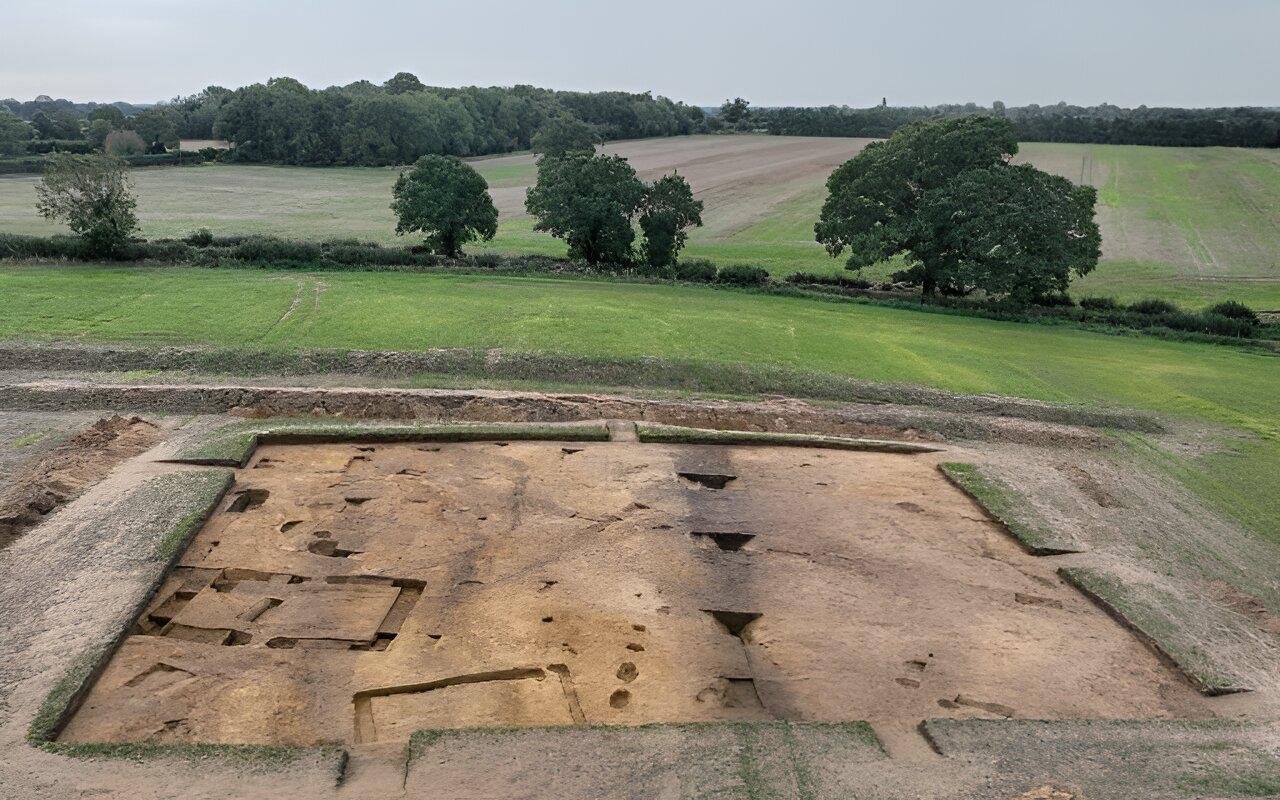Archaeologists, led by a team from University College London (UCL), have unearthed a possibly pre-Christian temple dating back 1,400 years in Rendlesham, Suffolk. The find is part of Suffolk County Council’s Rendlesham Revealed community archaeology project.
 Archaeological remains include the probable temple (left) and a boundary ditch (center) at the Rendlesham site in Suffolk, England. Credit: Jim Pullen/Suffolk County Council
Archaeological remains include the probable temple (left) and a boundary ditch (center) at the Rendlesham site in Suffolk, England. Credit: Jim Pullen/Suffolk County Council
The site, located near the renowned Sutton Hoo, had already gained attention last year when a large timber royal hall was uncovered, confirming it as a royal settlement.
This year’s excavations, however, have revealed a wealth of new discoveries, including a probable temple or “cult house.” The temple’s foundations, measuring 10 meters long and five meters wide, suggest it was unusually high and robustly constructed, possibly serving a special purpose.
Professor Christopher Scull, the project’s principal academic advisor affiliated with Cardiff University and UCL, emphasized the significance of the find: “The possible temple, or cult house, provides rare and remarkable evidence for the practice at a royal site of the pre-Christian beliefs that underpinned early English society.”
The discoveries also include evidence of fine metalworking ᴀssociated with royal occupation, such as a mould used for casting decorative horse harnesses similar to those found at Sutton Hoo.
What makes Rendlesham particularly unique is the scale and complexity of its royal compound. Recent revelations indicate the compound is more than twice the size previously estimated, enclosed by a 1.5-kilometer perimeter ditch, covering an area equivalent to 20 football pitches. This expansive royal residence is part of a broader settlement complex spanning 50 hectares, making it unparalleled in the archaeology of 5th to 8th century England.
The archaeological significance of Rendlesham goes beyond the medieval period. Excavations have unveiled evidence of human settlement and activity dating back 6,000 years, from the Neolithic period to the present day. The most recent findings include enclosures, two graves of unknown date, and remnants from the Neolithic, Bronze Age, Iron Age, and Roman periods.
The site’s connection to the East Anglian Kings is rooted in historical records. The Venerable Bede, an 8th-century historian, identified Rendlesham as a center of significance in the East Anglian Kingdom. According to Bede, King Redwald, who is believed to be buried at Sutton Hoo, maintained a temple with altars to pre-Christian Gods alongside an altar to Christ. Although Bede doesn’t explicitly mention Rendlesham, recent excavations strengthen the link between the site and the East Anglian Kings.
The project, funded by The National Lottery Heritage Fund and supported by over 200 local volunteers, including those from Suffolk Family Carers, Suffolk Mind, and local primary schools, has concluded its three-year excavation. With the trenches backfilled, analysis of the finds is underway, with provisional results expected in 2024.
Suffolk County Council’s Deputy Cabinet Member for Protected Landscapes and Archaeology, Councillor Melanie Vigo di Gallidoro, praised the findings, stating, “This year’s findings round off three seasons of fieldwork which confirm the international significance of Rendlesham’s archaeology and its fundamental importance for our knowledge of early England.”





